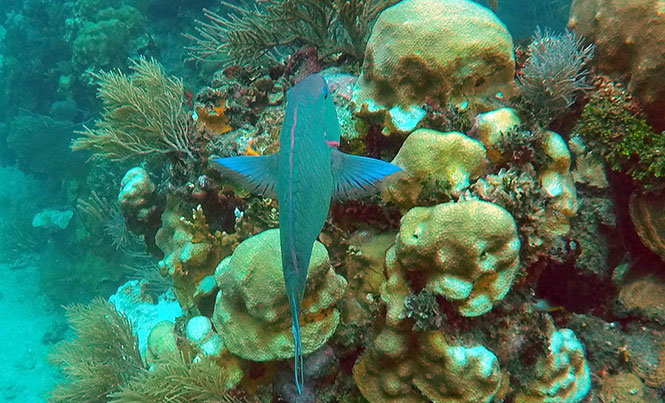
Long-term shifts from coral to macroalgae-dominated reef systems are well documented in the Caribbean Sea region. Caribbean reefs have gotten increasingly furry with macroalgae over the past decade, resulting not only in a far less pretty picture, but also in a far less productive and resilient ecosystem
About 80% of the reefs from the Caribbean Sea region have been lost, and although many politicians refuse to understand, coral reefs are a complex ecosystem which provides many important services to us such as tourism, fisheries, and coastal protection against storms. Protecting a small area of coral reef without considering its connectivity with other reefs and the key species for its health, is like attempting to build a castle on quicksand- it will be gone before you even finish building it.
Herbivore fish such as parrotfishes keep the reef’s health by eating a voracious coral competitor: macroalgae. Macroalgae fights with corals for ground to settle and grow, and once it has grown, it creates shading for neighboring corals. Macroalgae is part of a healthy coral reef system because is kept in balance by herbivore fish. However, populations of key herbivore fish have diminished on many Caribbean reefs due to long-term overfishing across the region and lack of species protection. When macroalgae´s major predators disappear, it takes over creating a dramatic shift between colorful and healthy coral reefs to unhealthy macroalgae reefs.
Parrotfishes are beautiful colorful fish absolutely critical for the coral reef’s health as they spend 90% of their time eating macroalgae that lives among corals. They are also important for beaches as they poop out sand (100 kg yearly). However, parrotfish have diminished in biomass in the Mexican Caribbean, which has contributed to the reef’s health decline. Efforts led by the Healthy Reefs Initiative along with government agencies (SEMARNAT & SEMA) and NGOs (COBI, CEMDA, & Kanan Kay Alliance) are currently working on communicating parrotfish importance towards species protection, and understanding the connectivity of larvae along the Mesoamerican Reef, which starts in Mexico.